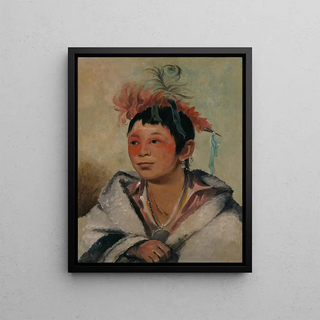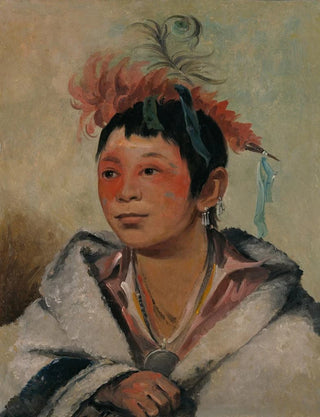Art print | A-Nah-Kwet-To-Hau-Py-O A boy sitting in the clouds - George Catlin


View from behind

Frame (optional)
In the fascinating universe of art, some works transcend the simple frame to become windows opening onto forgotten worlds. "A-Nah-Kwet-To-Hau-Py-O A boy sitting in the clouds" by George Catlin is one of these creations. This painting, evoking the poetry of the skies and the depth of the human soul, invites the viewer to a delicate contemplation. Through this artwork, Catlin does not merely depict a child; he captures the very essence of innocence and the spiritual connection between man and nature. The artist, as a witness of his time, offers a unique vision of Native American culture while providing an introspective look at the world around him.
Style and uniqueness of the work
The strength of "A-Nah-Kwet-To-Hau-Py-O A boy sitting in the clouds" lies in its distinctive style, where realism blends with a touch of romanticism. Catlin, master of color and light, manages to create an almost ethereal atmosphere, where the clouds seem to envelop the young boy in a cocoon of softness. The delicate shades of blue and white, combined with touches of earthy colors, evoke the serenity of a natural landscape. The child, sitting peacefully, appears to be both grounded in his environment and in communion with the skies. This contrast between earth and sky, between the tangible and the intangible, gives the artwork a rare emotional depth. Catlin, through his approach, reminds us that art can be a means of exploring universal themes such as innocence, spirituality, and the quest for identity.
The artist and his influence
George Catlin, an emblematic figure of the 19th century, is often recognized as the first artist to document the lives of Native American peoples through painting. His work is the result of a passionate ardor for the culture he encountered during his travels across the North American continent. Catlin does not merely reproduce scenes of daily life; he seeks to capture

Matte finish

View from behind

Frame (optional)
In the fascinating universe of art, some works transcend the simple frame to become windows opening onto forgotten worlds. "A-Nah-Kwet-To-Hau-Py-O A boy sitting in the clouds" by George Catlin is one of these creations. This painting, evoking the poetry of the skies and the depth of the human soul, invites the viewer to a delicate contemplation. Through this artwork, Catlin does not merely depict a child; he captures the very essence of innocence and the spiritual connection between man and nature. The artist, as a witness of his time, offers a unique vision of Native American culture while providing an introspective look at the world around him.
Style and uniqueness of the work
The strength of "A-Nah-Kwet-To-Hau-Py-O A boy sitting in the clouds" lies in its distinctive style, where realism blends with a touch of romanticism. Catlin, master of color and light, manages to create an almost ethereal atmosphere, where the clouds seem to envelop the young boy in a cocoon of softness. The delicate shades of blue and white, combined with touches of earthy colors, evoke the serenity of a natural landscape. The child, sitting peacefully, appears to be both grounded in his environment and in communion with the skies. This contrast between earth and sky, between the tangible and the intangible, gives the artwork a rare emotional depth. Catlin, through his approach, reminds us that art can be a means of exploring universal themes such as innocence, spirituality, and the quest for identity.
The artist and his influence
George Catlin, an emblematic figure of the 19th century, is often recognized as the first artist to document the lives of Native American peoples through painting. His work is the result of a passionate ardor for the culture he encountered during his travels across the North American continent. Catlin does not merely reproduce scenes of daily life; he seeks to capture






